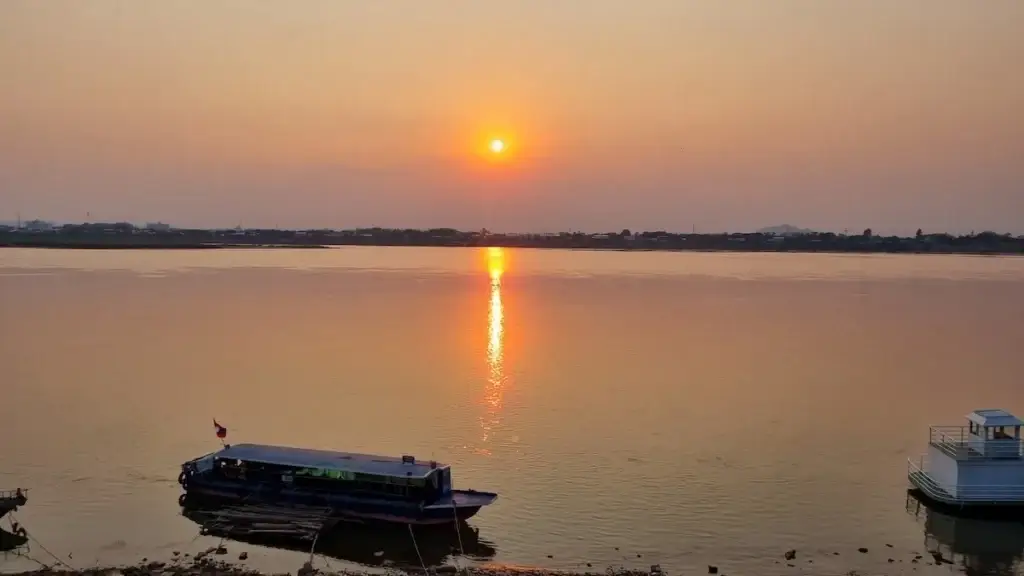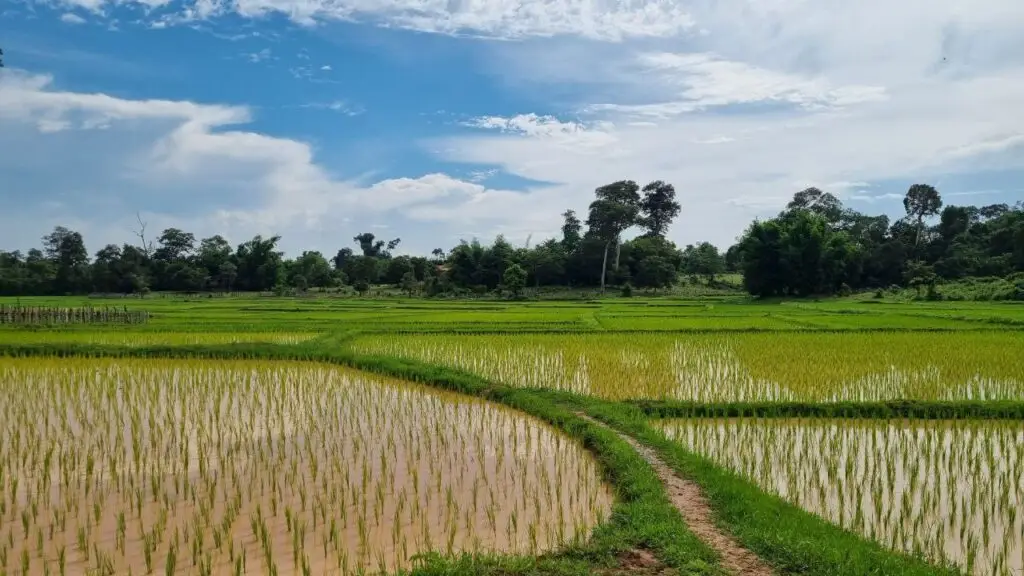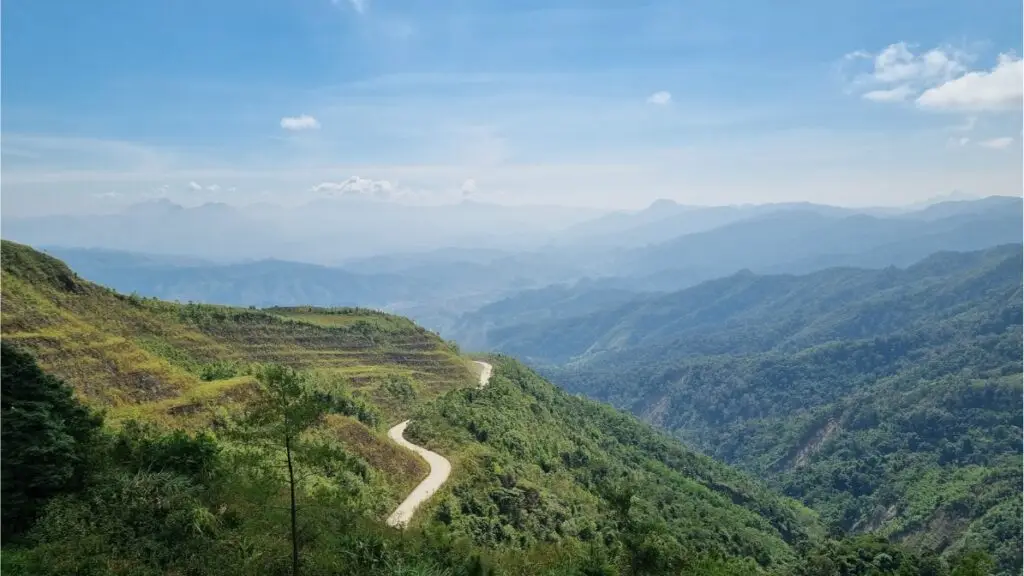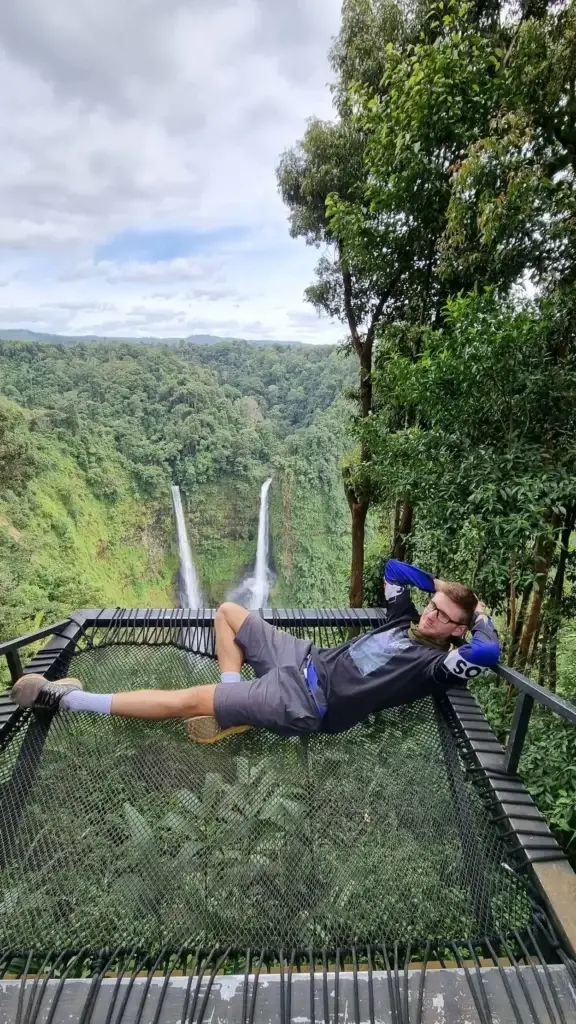
Disclosure: This article contains affiliate links. If you make a purchase through them, we may earn a small commission and you support our blog – at no extra cost to you.
Laos – officially named the LAO PDR (People’s Democratic Republic) doesn’t get as much international attention as their more popular Neighbours like Thailand or Vietnam. But that doesn’t mean that the only landlocked country in southeast Asia has nothing to offer – the opposite is the case. Visitors will be greeted by wonderful nature, mountainous terrain, hundreds of waterfalls, lots of outdoor activities, motorbike loops and probably the friendliest locals in all of southeast Asia. Pace of life is slower in Laos and many things are done “the lao way”.
It’s a war torn country packed with history and different cultures. Traveling to Laos means you’re entering one of the last authentic & wild places in Asia. Ready to explore real local life, paired with a lot of activities for travelers, people who been to Laos once will be back – 100%. If this is your first time, we will give you the most useful information in our unique Laos travel guide to avoid mistakes and be prepared for your unforgettable journey to this underrated country.
Basically it is quite easy: Don’t do anything you wouldn’t do in your home country. BUT: Your home country is probably a lot different than the Buddhist country of Laos. That’s already the first thing you need to know: Laos has a Buddhist Majority of around 66% or more. That means a huge amount of beautiful temples (“Wat”) to visit. At the same time that also means to dress properly when visiting a temple. In many touristic places in Thailand unfortunately people walk inside a temple with hot-pants or tank-tops, which is sad to see.

Laotians can be described as welcoming, humble, reserved, but curious, relaxed & respectful. Stress doesn’t really exist in Laos and time needs to be redefined, so don’t hurry. Learn how to go with the flow and don’t lose patience, especially not in public places. Screaming around or showing aggressive Behaviour is an absolut no-go! In popular tourist destinations locals may be used to see foreigners, but as soon as you step a bit out of the main attractions, a “farang” (western tourist) can quickly become the center of attention. Especially kids will approach with a big smile and “Sabaidee” (lao word for hello). It’s important in Lao Culture to respect elders, so you should do the same when greeting or talking to people who are obviously older. Here are some general practical tips for Do’s and Dont’s in the real land of smile:
There are several options how to travel to Laos. Most common ones are by airplane, followed by bus, train or boat. Laos is landlocked and has no direct sea access, but traveling by boat is still possible on the mighty Mekong River. We will briefly list the different varieties of transportation.
Most visitors probably arrive by airplane in Laos. The biggest airport ist Wattay International Airport (VTE) in the Capital Vientiane. Although the airport and level of business can not be compared with airports like Suvarnabhumi or Don Muang Airport in Thailand. Wattay International Airport is quite relaxed. Therefore it is also likely to have a stopover in Bangkok as there are not as many direct flights to Laos as there are to megacities like Bangkok.
Those are some of the most common routes by plane to travel to Laos from other neighbouring countries. I recommend using Trip.com to research departure times. Another very useful website is flightconnections.com. You can check departures and arrivals from and to any airport in the world.
A more budget friendly option, but also longer journey is to go by bus. There are plenty of busses departing from Thailands Northern Bus Terminal Mochit to Nong Khai or Vientiane. The trip takes at least 10 – 12 hours. Usually busses are comfortable and overnight options are available.
Border Crossings: Ensure you have the necessary visa and travel documents. Some borders offer visas on arrival; verify current policies before traveling.
Travel Conditions: Overland routes can be long and taxing due to road conditions. It’s advisable to check recent traveler reviews and prepare accordingly.
Booking: During peak seasons, transportation options can fill up quickly. It’s recommended to book tickets in advance and confirm schedules, as they can change.
Laos does not have direct sea access, but there is an option to travel by Slow Boat on the Mekong River. The journey starts in the Thai border town Chiang Khan. Travelers cross the Thai-Lao Friendship 4 to Huay Xai on the Lao side of the Mekong. Duration is 2 days with an overnight stop in Pak Beng. Departures times are daily between 09:00 – 11:00 am.
Itinerary Slow Boat:
Day 1: Huay Xai to Pak Beng:
Day 2: Pak Beng to Luang Prabang:
Tickets can be purchased at the border in Huay Xai directly or beforehand via tour agencies in Chiang Rai or Huay Xai (more expensive).

In general Laos is a Destination hat can be visited all year around, but there are few important things to know when deciding on what time is best time to visit Laos for you to go. As it’s a tropical country, there are basically 3 main seasons.

Depending on how much time you want to spend in Laos and what your preferences are, all of the mentioned season have it’s advantages and disadvantages. Bring more time for raining season, but you will be awarded with the most beautiful scenery. If you want to experience Lao New Year, come in April, but better avoid places like Luang Prabang or Nong Khiaw because of the slash and burn practices and hazardous air quality in the Northern part of Laos. Good times to visit are also the transitions months between the seasons: October, February and June.
First of all: Laos is safer than bigger cities in Europe and the USA! Crime rates in Laos are low and violent crime is rare. Locals are among the friendliest people in the world and for me it is the real land of smiles. Terrorist attacks are unknown and it’s a very sleepy, laid back country, where stress doesn’t exist. Live and let live is something that’s very common here. As a tourist, especially for first-timers, here are some more tipps on safety in Laos:
Laos is as well a safe destination for solo-female-travelers. Many westerners complaining about road safety or hygienic standards. Please do keep in mind that Laos is a developing country and cannot be compared with western countries. Things are very different here. Be respectful, don’t loose patience in public and go with the flow. Most important: Don’t try to change Laos, Laos will change you in a better way. Other than that: Use common sense and don’t do things you wouldn’t do back in your home country!

A question which is almost impossible to answer, therefore we will keep it short and simple. Your itinerary depends on how much available time you have. Laos is not very densely populated, but a big country. That means traveling from A to B requires time. If you have only a few days, stick to one city in a province. One week or more is just enough for the main highlights for example in Luang Prabang and Vang Vieng. Better to have at least 2-3 weeks for Northern Laos including Vientiane, Vang Vieng, Luang Prabang & Nong Khiaw. It should be minimum 4 weeks if you want to discover more of the North (Luang Namtha, Phonsavan, Phongsali). But in 3-4 weeks it’s also possible to see some of the highlights in the North as well as some highlights in central or southern Laos (Thakek, Savannakhet, Pakse, 4000 Islands). For curious travelers who want to fully immerse in Laos, at least 5-6 weeks are recommended. Many tourists coming to Laos make one big mistake: They rush. And this is exactly what not to do in the Lao PDR. Don’t plan too much, go with the flow, explore local life and not only stick to the main attractions.

For visitors from EU countries, USA, Canada and many other countries, it’s easy to obtain a Laos Tourist Visa on Arrival, either at the airport or at some land border crossings. Visa on Arrival costs 40 USD and should be paid with banknotes in perfect conditions. It is also possible to pay in Thai Baht, but the immigration officials will give you a very bad exchange rate, that you will be around 50 USD in the end (approx. 1800 THB). Prepare 1-2 passport size pictures as well. If you don’t have passport size pictures, it’s not a big deal and you can pay a small fee of 1-2 USD. Land borders in Southeast Asia are infamous for being corrupt. Some border officials at land borders will try to charge you an additional amount of 100-200 THB. This can simply be refused by asking what it is for and where the official sign for that is. If you arrive at a land border crossing after 4 PM expect to pay an overtime fee of 10.000 LAK. They will give you a slip for that.
The eVisa is more convenient, but slightly more expensive. Expect to pay 50 USD + a small service fee. The advantage is, that you don’t need to fill out the paperwork at the border and can avoid queues at busy border entries like Vientiane or Luang Prabang. This is the official Lao eVisa Website: https://laoevisa.gov.la/index
Lao Tourist Visa is a single entry visa, which means once you leave and plan to come back, you have to pay again for a Visa. A Tourist Visa (VOA or eVisa) will be granted for 30 days and can be extended in Laos at any immigration police office for another 60 days (30+30) up to a maximum stay of 90 days. Check visa requirements for your nationality before arriving in Laos.
Hygienic Standards in Laos are different than most western travelers are used to from their home countries. It is a third world country and medical facilities are mostly basic. But there are bigger and better equipped hospitals in the capital Vientiane and Luang Prabang though. Hospitals like Alliance Medical Center, Kasemrad International Hospital or French Medical Center in Vientiane have good Standards and also english speaking staff. If you’re in Luang Prabang, the Luang Prabang Provincial Hospital upgraded their facilities and can be visited if you seek medical advice. Those are some of the better medical facilities in the country.
Other than those, every province has a provincial hospital and every district has some smaller medical clinics. For serious cases, it is recommended to visit a hospital in Thailand. From Vientiane the city of Nong Khai or Udon Thani are not far. If in central or southern Laos and you’re looking for serious treatment, there are good hospitals in Mukdahan or Ubon Ratchathani.
If you simply need some medicine, there is nothing to be worried about because Laos has plenty of pharmacies in every city, even in smaller towns. Typical pharmaceuticals for travelers you will usually find in those small pharmacies. Be aware that the name or brand of tablets you’re used to, probably have a different name here. Lao pharmacies usually sell Thai, Vietnamese or Lao medicine. They definitely got you covered when you need some anti-diarrhea medicine, electrolyte powder, painkillers or antibiotics.
Malaria:
Travelers frequently ask in facebook group about the risk of Malaria in Laos and the simple answer to that is: Don’t worry! Malaria is not fully eradicated yet, but is not a risk for the typical tourist anymore. There are only a few areas left, where sometimes still some Malaria cases occur and thats only in very rural and forested areas in Savannakhet, Salavan & Sekong Province. The normal tourist will not step into those remote areas anyway and after living in Laos for many years, I have never heard of a single case of Malaria, even though I spend a lot of time in exactly those mentioned areas.
Dengue Fever:
But one tropical disease to be aware of is “Dengue Fever”. Another Mosquito-Borne Disease. There is no vaccine available and prevention is key. Use mosquito repellent with “DEET” and wear long sleeves when doing jungle treks. Like all Mosquito-Borne diseases, during raining season there is a higher risk of transmission (June – October). Compared to Malaria, Dengue Fever is present all around Southeast Asia and preventive measures should be considered traveling anywhere in the region.
Japanese Encephalitis:
Very rare, but present in rural jungle areas. There is an expensive vaccine for that, but you have to decide wether it’s worth it or not. The vaccine is recommended for long-term residents or travelers in rural areas. Also never heard a single case of Japanese Encephalitis. This is no medical advice though, consult your Doctor instead!
One more thing about Rabies: Stop petting every dog – it’s Southeast Asia, not Europe! Especially Farang tend to touch every single dog and cat, just don’t do it and you’ll be fine. Even if bitten by a Rabies infected animal, you can still get the vaccine afterwards within a period of 24 hours. Wash the wound immediately, apply antiseptic, seek medical advice and don’t wait too long for getting a Rabies shot.
The official currency in Laos is the Lao Kip (LAK) and the government wants you to use the LAK only. But sometimes it may be possible to use Thai Baht or USD, especially for bigger purchases. In the last 4 years, the LAK devalued a lot compared to other stronger currencies and inflation rate is high (around 8% in May 2025). For tourists bringing one of those stronger currencies (USD, EUR, etc.), life is cheap in Laos. Most of the things for tourists in Laos are cheaper than in Thailand. Getting money out of the ATM is also easy. The max. amount of cash which can be withdrawn from the biggest bank called “BCEL – Banque Pour Le Commerce Exterieur Lao Public” is 2 Mil. LAK + an ATM fee of 30.000 LAK. There are many other banks, but usually have even lower limits or higher fees, such as: LDB – Lao Development Bank, Lao-Viet Bank, Phonsavan Bank or JDB – Joint Development Bank.
It’s also possible to pay by QR-Code. Almost every restaurant, shop and vendor have QR-Codes displayed, which can be scanned with a Lao Bank account. As tourist don’t have a Lao Bank Account, there is an option for travelers called “Loca Pay”. With Loca Pay every Lao QR-Code can be scanned, so you don’t need to worry of carrying huge amounts of cash with you. Loca Pay can be connected with any international credit or debit card. The fee is 3% + 5000 LAK. So it’s your decision of using cash or cashless payments.
Recommended for taking out cash in Laos: WISE (former Transferwise) – With WISE you can withdraw money from any ATM and they will give you the realtime exchange rate, which is much better than 99% of the traditional banks out there. An alternative to WISE is REVOLUT. Using your Revolut card, will give you a very good exchange rate when taking out LAO KIP from any ATM in the country (small exchange fees apply). With Wise you can take out up to 200 $ per month for fee, same as with Revolut. So if you have both cards (backup card recommended anyway), you can already withdraw 400 $ per month from any ATM in Laos for free. Both Wise & Revolut are completely free to use and make traveling smoother. Wise & Revolut can easily be controlled by App.
When arriving to a new country it’s always nice to have some apps installed, which make traveling easier. Raid hailing apps, payment wallets or sim card related apps to stay connected. Here are some of the most useful apps in Laos:
Laos is a hidden gem in Southeast Asia, offering a perfect mix of stunning landscapes, rich culture, and laid-back vibes. Whether you’re exploring majestic waterfalls, riding motorbike loops, or experiencing local traditions, this country offers an authentic adventure unlike anywhere else. Life moves at a slower pace here, so embrace the “Lao way” and enjoy the journey rather than rushing through. With friendly locals, diverse activities, and endless natural beauty, Laos will leave a lasting impression—and chances are, you’ll be back for more! Ready to explore? Take your time, stay curious and enjoy every moment in this underrated paradise. 🇱🇦✨